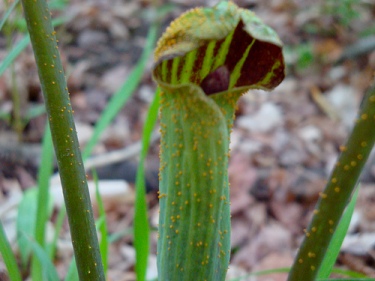Jack and His "Friends"
The jack-in-the-pulpit is involved in several different types of interactions with many other organisms. Since the flowers are located inside the spathe, the jack-in-the-pulpit cannot rely on the wind for pollination. This means the main way pollen is transferred from male plants to female plants is via insects.
The insects involved in pollen transfer are mainly flies. The flies enter the spathe and proceed to the bottom of it, which is often more lightly colored than the rest of the spathe. At this point, the fly can pick up pollen in a male plant or drop off pollen in a female plant. In order to attract fungus flies, the spadix of the jack-in-the-pulpit produces an odor similar to that of a mushroom.
 Some
organisms also eat the jack-in-the-pulpit,
like the
mosquito(Anopheles
earlei), in picture to the left.
Different species of birds eat the berries
it produces. This benefits the bird by
providing a food source and it also benefits
the jack-in-the-pulpit by providing a means
of distribution for its seeds. Deer
also eat the leaves of the
jack-in-the-pulpit despite the calcium
oxalate crystals inside them. Check out more
organisms in the jack-in-the-pulpit's area
by going to the
habitat page.
Some
organisms also eat the jack-in-the-pulpit,
like the
mosquito(Anopheles
earlei), in picture to the left.
Different species of birds eat the berries
it produces. This benefits the bird by
providing a food source and it also benefits
the jack-in-the-pulpit by providing a means
of distribution for its seeds. Deer
also eat the leaves of the
jack-in-the-pulpit despite the calcium
oxalate crystals inside them. Check out more
organisms in the jack-in-the-pulpit's area
by going to the
habitat page.
Uromyces aritriphylli
is a parasitic fungus that often attacks the
jack-in-the-pulpit. You can see a
picture of an infected jack-in-the-pulpit
below. Infected plants
generally have lesions on their surfaces.
These lesions are yellow in color and
produce spores. In a given population
of Arisaema triphyllum, as
many as 1/4 of the plants may be infected.
This infection has many repercussions on the
plant itself. It inhibits pollination
by causing deformed spathe formation and
decreasing the ability to vegetatively
propagate. In addition, infected
females cannot produce seeds.
Humans also interact with the jack-in-the-pulpit. In the 19th century, the plant was partially prepared and used to treat several different diseases like ashtma, rheumatism, and whooping cough. The plant could only be partially dried because it worked by creating irritation. This was a rather tricky process, as a plant that was too dried would be useless, but one that wasn't dry enough could be deadly.
Beyond this, there are a few other medicinal uses for the jack-in-the-pulpit. Elements of the plant can be used in skin ointments, poultices, and tonics. The plant, usually the root, can also be eaten if thoroughly dried, roasted, or leeched. American Indians were noted for eating the corm, which earned Arisaema triphyllum one of its common names, the Indian turnip. Want to know some other cool stuff about the jack-in-the-pulpit? Take a look at the interesting facts page!
